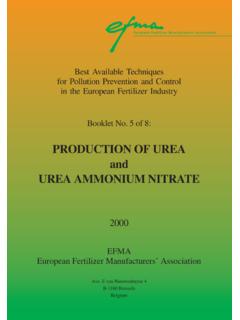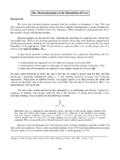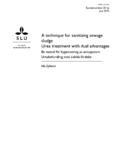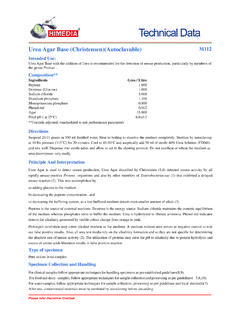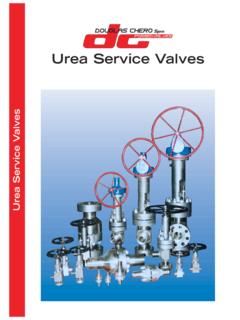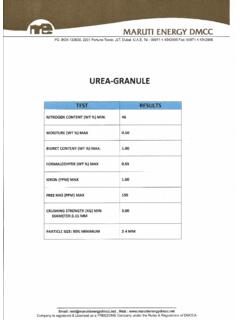Transcription of Urea to Ammonia (U 2A™ ) systems: Operation and …
1 1 urea to Ammonia (U2A ) systems: Operation and process chemistry Prepared by: Suchismita Bhattacharya and H. James Peters Hamon Research-Cottrell, Inc., 58 E Main Street, Somerville, NJ 08876 Jeff Fisher Wahlco, Inc., 3600 Segerstrom Avenue, Santa Ana, CA 92704 Herbert W. Spencer III EC&C Technologies, Inc. 4234 Chevy Chase Drive, LaCanada, CA 91011 Paper #: 115 ABSTRACT Hamon Research Cottrell and Wahlco, Inc., under license from EC&C Technologies have supplied U2A systems with Ammonia duty rated at various maximum capacities from 10 to 10,000lb/hr. This paper describes the Operation of a U2A ( urea to Ammonia ) reactor sized for a rated capacity of 460 lb Ammonia / hr for a coal-fired power plant SCR.
2 The constant pressure system allows a controlled response to changes in NOX-load that is almost instantaneous. Data shows that this reactor was able to operate over loads ranging between 50 and 400 lb/hr Ammonia . The U2A reactor system demonstrated smooth start-up and shutdown characteristics and provided 98% availability during its first operating season. Data analysis shows how low and high load Operation influence composition of the equilibrium reactor solution. Sample analysis of the reactor liquid shows that speciation of the reactor liquid is the same as urea feed with levels of the reaction intermediates varying somewhat with load. At the end of season, inspection of the reactors revealed that internal surfaces and tubes were clean and accumulation of residuals was nominal.
3 The absence of significant residuals demonstrates the complete nature of the urea hydrolysis reaction in the U2A system . 2 INTRODUCTION The development of urea -to- Ammonia technologies is in response to the greatly increased requirements for utilities to control NOx emissions and their implementation of SCR projects that require Ammonia as the reducing agent at the catalyst. Anhydrous Ammonia is regarded as a hazardous and toxic chemical and is subject to strict regulations imposed by the EPA, OSHA and additional restrictions by local authorities. Aqueous Ammonia , although less concentrated, poses similar risks, and is also becoming increasingly regulated or subject to restrictions. The use of aqueous Ammonia as an alternative to anhydrous, significantly increases operating costs for chemical and energy, and increases transport and storage requirements, especially for more dilute aqueous solutions.
4 The urea to Ammonia (U2A ) system uses urea as the feedstock chemical and thereby entirely avoids risks associated with the transportation and bulk storage of Ammonia . Since the Ammonia equivalence of urea is approximately 56%, urea provides a lower operating cost chemical compared to lower concentration aqueous Ammonia and an economic alternative where use of anhydrous Ammonia is not desirable. COMMERCIAL EXPERIENCE Utilities are increasingly adopting urea as the preferred alternative to Ammonia for their SCR projects. At present, systems installed or in design represent a total Ammonia capacity of approximately 25,000 lb/hr NH3 serving 10,000 MWe in the and Europe on gas turbine and gas and coal fired boiler SCR systems.
5 The first U2A commercial installation has accumulated approximately 16,000 hours Operation to date. The scope of these installations includes urea storage, handling, urea solution preparation, solution feed and control system , hydrolysis reactors and Ammonia flow control units for systems ranging from 10 lb/hr to 10,000 lb/hr Ammonia . process BACKGROUND U2A technology was developed by Emission Control & Chemical Technologies (EC&C) under grant sponsorship from the EPA's SBIR program. As a result of the successful development work, EC&C made its initial filing with the Patent office on March 21, 1997. Patent 6,077,4911 was issued on June 20, 2000. Additional patents (US 6,322,762 B1, Nov. 27, 2001, US 6,436,359 B1, Aug.)
6 20, 2002 and US 6,506,350 B2, Jan 14, 2003) have since been issued and other applications are pending. In the urea to Ammonia (U2A ) process , an aqueous solution of urea is converted to a gaseous product of Ammonia , carbon dioxide and water vapor by thermal hydrolysis described by the following overall reaction: O(x)H CO 2NH O(x)H COONHNH Ox)H(1 CONHNH 223224222++ + ++ The reaction occurs in two steps and overall is endothermic. The first reaction involves the production of ammonium carbamate from the combination of urea and water. 3 Ammonium carbamate then breaks down in the presence of a heat source to form carbon dioxide and Ammonia , with the excess water leaving the system as vapor. Both reactions take place in the liquid phase in the reactor.
7 The break down of ammonium carbamate is pressure dependent. At the operating pressure of approximately 80 psig, the carbamate dissociates at 98 C (208 F). Above this temperature the reaction favors the formation of Ammonia . Below this temperature, at times during shut down of the system , the Ammonia and carbon dioxide gases will recombine to form ammonium carbamate. The rate of generation of Ammonia by this reaction can be described by the Arrhenius equation which is of the form )kT-E(e AR = Where A is proportional to the number of moles of water and urea in the reactor, and E is the activation energy for the reaction. The concentration of urea in the reactor and the temperature of the reactor influence the generation rate of Ammonia .
8 Below 115 C (239 F) the reaction does not occur at significant rates. Since the overall reaction is endothermic it is easily controlled by regulating the heat added to the reactor which is operated at constant pressure. The U2A reactor itself is a kettle-reboiler style heat exchanger, normally rated at 300 psig and fitted with a closed steam tube bundle or heating elements for heat input. When using steam, heat is provided by a nominal 150-250 psig steam. U2A reactors operate typically at 80 psig and 300 F. 0500100015002000250030002002252502753003 25 Temperature (deg F)Production Rate (lb/hr NH3) based on 40% urea solution feedFigure 1: Reaction rate as a function of operating temperature 4 Figure 1 shows the exponential relationship between the operating temperature of the reactor and the relative production of Ammonia .
9 After a temperature threshold has been reached, the Ammonia generation rate increases rapidly with temperature. Typically, the operating temperature cycles daily from high load Operation at about 300 F to low load Operation at about 285 F. In practice, level and pressure are held constant, and temperature varies slowly. This provides a stable dynamic equilibrium and since the U2A process operates as a once-through process ; the gas product leaving the reactor is at a known concentration that is the equivalent to the composition of the urea solution feed as shown in Figure 2. Figure 2: The product gas composition relationship to urea feed concentration. Two typical cases are outlined below.
10 urea solution (wt%) 40% 50% U 2A product gas (vol%) (vol%) Ammonia Carbon Dioxide Water Vapor 5 Some optimization of the process is possible by operating with higher urea solution concentration. In addition to the heat requirements of the endothermic reaction, the process requires energy to process the excess water introduced with the urea solution. Therefore, Operation at higher solution concentration reduces the energy requirements for the process . At the same time, the reaction rate versus temperature characteristic increases with higher urea concentration, allowing smaller reactors. These considerations are balanced against requirements for heat tracing to maintain proper temperatures in feed lines and other piping systems.
